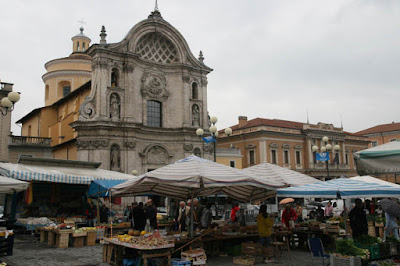Abruzzo: L'Aquila
The Province preserves significant natural endowments, including the Abruzzo, Lazio and Molise National Park, the oldest park in Italy
Due to its dimensions, it presents a great variety of customs and traditions, history and dialects, but an underlying thread runs ever through them. Because of such diversity, the people of Avezzano and Sulmona have long expressed their desire for independent provincehood.
This is a small story of hope.
Abruzzo, L'Aquila and its suburbs was almost destroyed in the night between 5 and 6 April 2009 from an earthquake of unimaginable violence. People, animals, houses and unrepeatable works of art, in 20 terrifying seconds, were deeply affected. These wounds cannot be be erased from the mind but the SOLIDARITY manifested by rescuers, opens a hope that is stronger than the pain. Here's a little story that proves it. The students who were the most affected, trying to retrieve their most important things from houses destroyed. But the buildings are at risk and then, here's the "angels of the earthquake": that of civil protection volunteers, the firemen.
Also to embrace again a tiger of peluche may help to hope again. At present, restoration is in progress.
Thank you "angels of the earthquake"!
L'Aquila contains many vestiges of its late medieval glory, and fine examples of romanesque and renaissance art.
S.Maria di Collemaggio, built in thirteenth century, is a masterpiece of the Abruzzi Romanesque style with its magnificent white and pink facade. S. Bernardino da Siena is one of the finest examples of the renaissance architecture in Abruzzo. The Spanish Castle is the largest fortress in the region and represents a fine example of military architecture perfectly preserved.
 The Fountain of 99 Spouts, designed by Tancredi da Pentina, is one of the most unusual in Italy. but perhaps the real charm of L'Aquila lies in its hidder corners and courtyards, and the pleasure of emerging from a dark, narrow street to discover an intersting church or fountain.
The Fountain of 99 Spouts, designed by Tancredi da Pentina, is one of the most unusual in Italy. but perhaps the real charm of L'Aquila lies in its hidder corners and courtyards, and the pleasure of emerging from a dark, narrow street to discover an intersting church or fountain.
The main square of the town is what the people of L'Aquila call "La Piazza".
Other Churches and patrician palaces of interst are: S.Silvestro (14th century), S. Maria del Soccorso (15th century), S. Giusta (12th century), S. Domenico;
palaces: Centi (18th century), Benedetti (18th century), Rivera (18th century), Dragonetti (15th century), Carli (16th-18th century), De Nardis, Palazzatto dei Nobili, Ardinghelli (18th century), Quinzi (18th century), Franchi-Cappelli (16th century), Branconio (16th century) and the whole City .
Due to its dimensions, it presents a great variety of customs and traditions, history and dialects, but an underlying thread runs ever through them. Because of such diversity, the people of Avezzano and Sulmona have long expressed their desire for independent provincehood.
This is a small story of hope.
Abruzzo, L'Aquila and its suburbs was almost destroyed in the night between 5 and 6 April 2009 from an earthquake of unimaginable violence. People, animals, houses and unrepeatable works of art, in 20 terrifying seconds, were deeply affected. These wounds cannot be be erased from the mind but the SOLIDARITY manifested by rescuers, opens a hope that is stronger than the pain. Here's a little story that proves it. The students who were the most affected, trying to retrieve their most important things from houses destroyed. But the buildings are at risk and then, here's the "angels of the earthquake": that of civil protection volunteers, the firemen.
Also to embrace again a tiger of peluche may help to hope again. At present, restoration is in progress.
Thank you "angels of the earthquake"!
L'Aquila contains many vestiges of its late medieval glory, and fine examples of romanesque and renaissance art.
S.Maria di Collemaggio, built in thirteenth century, is a masterpiece of the Abruzzi Romanesque style with its magnificent white and pink facade. S. Bernardino da Siena is one of the finest examples of the renaissance architecture in Abruzzo. The Spanish Castle is the largest fortress in the region and represents a fine example of military architecture perfectly preserved.
 The Fountain of 99 Spouts, designed by Tancredi da Pentina, is one of the most unusual in Italy. but perhaps the real charm of L'Aquila lies in its hidder corners and courtyards, and the pleasure of emerging from a dark, narrow street to discover an intersting church or fountain.
The Fountain of 99 Spouts, designed by Tancredi da Pentina, is one of the most unusual in Italy. but perhaps the real charm of L'Aquila lies in its hidder corners and courtyards, and the pleasure of emerging from a dark, narrow street to discover an intersting church or fountain.The main square of the town is what the people of L'Aquila call "La Piazza".
Other Churches and patrician palaces of interst are: S.Silvestro (14th century), S. Maria del Soccorso (15th century), S. Giusta (12th century), S. Domenico;
palaces: Centi (18th century), Benedetti (18th century), Rivera (18th century), Dragonetti (15th century), Carli (16th-18th century), De Nardis, Palazzatto dei Nobili, Ardinghelli (18th century), Quinzi (18th century), Franchi-Cappelli (16th century), Branconio (16th century) and the whole City .




Comments
Post a Comment
Thanks for leaving your comment